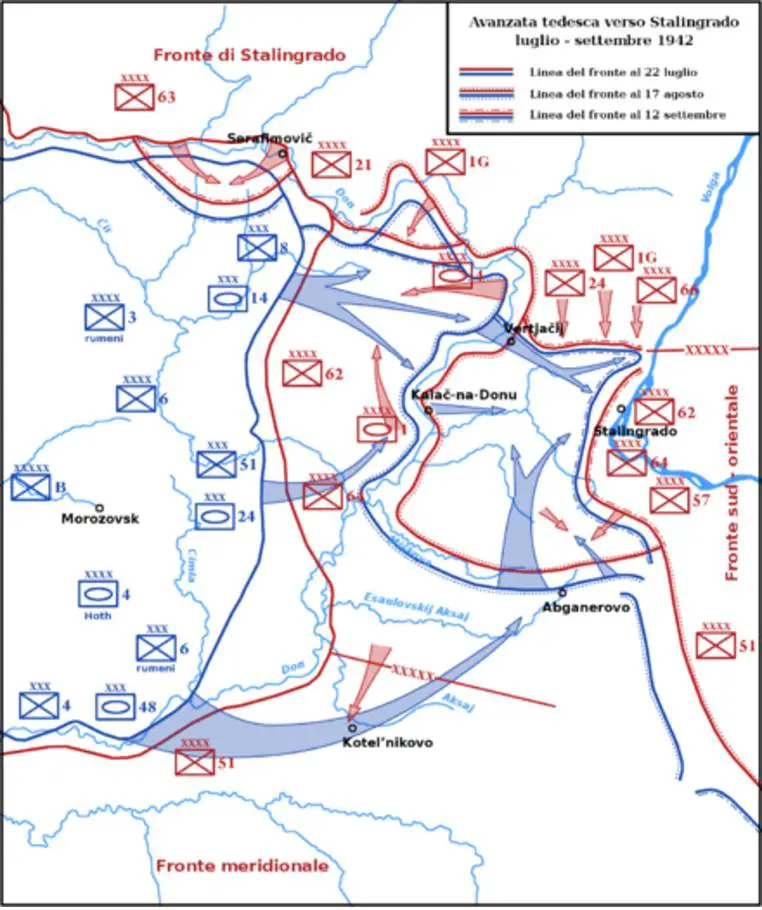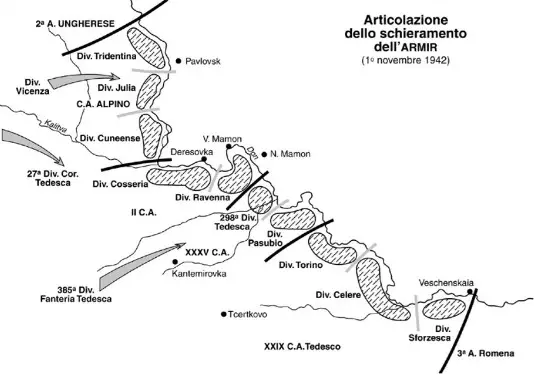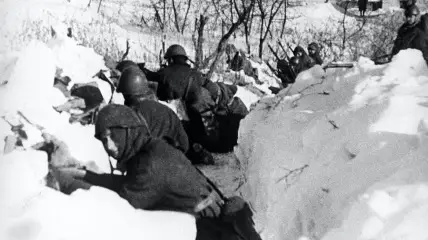From CSIR to ARMIR
In a previous chapter, we have discussed the role played by the Italian Expeditionary Corps (CSIR) on the Eastern front in 1941.
In 1942, after the failed capture of Moscow, the Germans planned a new summer offensive towards the Caucasus region and the city of Stalingrad.
The offensive would have required a vast effort in terms of men and equipment. This led Adolf Hitler to accept Mussolini’s offer to increase the Italian presence on the Eastern front. The Duce had offered more troops already in summer 1941 when the CSIR units were just leaving Italy, but such offer had remained unaddressed. In winter 1941-1942 the Germans accepted the renewed Italian support and preparations began for the transfer of the new army corps. These were:
-II Corps, formed by the divisions “Cosseria”, “Sforzesca” and “Ravenna”.
– Alpine corps, formed by the elite Alpini divisions “Julia”, “Cunense” and “Tridentina”.
From the 9th July 1942, these units, together with the CSIR (renamed XXXV corps) were organized in the new 8th Army or “ItalianArmy in Russia” (ARMIR). The new army could also count on additional black shirt legions (battalions), the Croat legion, and the infantry Division “Vicenza”, for anti-partisan and police duties.
Facing the upcoming increase of Italian troops, General Messe, commander of the old CSIR, warned that the logistical situation would have deteriorated, given the shortage of trucks, the long distances, and the bad roads of Soviet territory. Messe even traveled back to Italy to personally report on the situation and warn against the transfer of more troops. Instead, he requested the substitution of his most exhausted divisions, the “Pasubio” and the “Torino”
His warnings remained unheard. Once more, Mussolini took a fatal decision by just looking at the political situation, ignoring the reality on the field. The Soviet Union was believed to be on the brink of collapse, the Duce wanted his fair share of glory and could not accept that Hungarians or Romanian troops were more numerous than the Italians on the Eastern front. Sources report that, in reply to Messe’s arguments, the Duce stated that the 229.000 men of the ARMIR would have had a bigger weight than the 60.000 of the CSIR during peace negotiations.
The ARMIR could then count on 229.000 men, 600 artillery pieces, 297 anti-tank guns (including the new 75/34 guns), 16.700 vehicles and trucks, 19 Semovente 47/32, 31 L6/40 light tanks, and a handful of Ab41 armored cars. The army also relied on 25.000 Mules. This force was put together using the best available equipment (like the Anti-tank and AA guns), diverting huge resources from the main theatre of operation for Italy, which was North Africa.
In addition, the experienced General Messe was not chosen to lead the new Army, Marshal Cavallero, Chief of General staff, selected instead Italo Gariboldi, an old Army Commander with no significant skills and no experience of the Eastern front. Cavallero chose him because disliked Messe and his increasing prestige (gathered on the field). A very pitiful power dynamic.
The ARMIR in “Fall Blau”

At the end of June 1942, the new German summer offensive (codename Fall Blau) began, by the end of July, they had reached the river Don and the 6th Army of Friedrich Paulus was marching towards Stalingrad, Hungarian, Romanian and Italian units were tasked to protect the flanks of the German 6th Army.
In this context, units of the XXXV corps (the old CSIR) fought in the upper Don basin, in particular around the town of Serafimovich. The 3rd “Celere” division, with its Bersaglieri and Cavalry units, was heavily involved in the fights and, by mid-August, it withdrew to pause and recover. The Celere was substituted with the newly arrived division “Sforzesca” which had no fighting experience on the Eastern front but was the only fresh unit available.
The inevitable Soviet counterattack occurred in this area, aimed at halting the German drive on Stalingrad. The Sforzesca was badly hit and force to withdraw a few kilometers back. With no other available units, General Messe sent in again the Celere division. In the last ten days of August, the Celere, later supported by some German units and some newly arrived Alpini battalions, managed to stabilize the front. During these fights, took place the famous cavalry charge of the regiment “Savoia Cavalleria” at Izbushensky. Also, the 3rd Bersaglieri regiment and some Blackshirts battalions participated in the heavy fights and contributing to halt the Soviet assault. These attacks, which granted the red army a foothold on the west bank of the river Don, proved that the Italians could not hold a front line of around 270 km long.
By early September, the entire CSIR was deployed on the west bank of the Don river, also the Alpine corps had arrived (although previously destined to the Caucasian front).
Dig in for the winter
For the time being, no more attacks came from the red army and the ARMIR dug in to face the Russian winter. In October, the 3rd Romanian army was deployed east, between the ARMIR and the German 6thArmy fighting in Stalingrad while the Hungarian held the Don line north-west of the Italians.

As it can be grasped by the map, the left flank of the ARMIR was held by the Alpine corps (Cunense, Tridentina, and Julia divisions). The Cosseria and the Ravenna divisions held the center, reinforced by the German 298° division. The divisions of the old CSIR held the right flank (Pasubio, Torino, Celere). The badly hit “Sforzesca” held the junction between the ARMIR and the Romanian army. The Division “Vicenza” and the German 27° Panzer and 385° divisions remained in reserve. The front held by the Italians was now 230 km long, still, quite a lot to mount an effective defense against a massive Soviet assault.

With the battle of Stalingrad raging on, the German logistics came progressively under more pressure, in several occasions, Italian and German units came close to the clash for the distribution of supplies. With temperatures sharply decreasing, fewer supplies reaching a thinly defended front, the ARMIR awaited in its trenches for the (second) inevitable Soviet counterattack.
Sources
Jowett, P. (2019). L’esercito italiano nella seconda guerra mondiale. LEG edizioni.
Petacco, A. (1998). L’ Armata scomparsa. l’avventura degli Italiani in Russia. Mondadori.
Schlemmer, T. (2005). Invasori, non vittime: la campagna italiana di Russia 1941-1943.